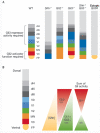Gli proteins and the control of spinal-cord patterning
- PMID: 12897799
- PMCID: PMC1326336
- DOI: 10.1038/sj.embor.embor896
Gli proteins and the control of spinal-cord patterning
Abstract
The secreted protein sonic hedgehog (Shh) is crucial for the specification of neuronal subtype identity in the vertebrate neural tube. Zinc-finger proteins of the Gli family are known to be transcriptional mediators of Shh signalling, and to coordinately pattern the dorsal-ventral axis of the spinal cord. Recent studies indicate that additional signals may provide positional information in parallel to Shh to specify neuronal fate in this tissue. We review the role of Gli proteins in spinal-cord development and propose that various upstream patterning signals may be integrated by the Gli proteins to direct a coherent programme of neurogenesis.
Figures


Similar articles
-
Combinatorial Gli gene function in floor plate and neuronal inductions by Sonic hedgehog.Development. 1998 Jun;125(12):2203-12. doi: 10.1242/dev.125.12.2203. Development. 1998. PMID: 9584120
-
Dorsal-ventral patterning of the spinal cord requires Gli3 transcriptional repressor activity.Genes Dev. 2002 Nov 15;16(22):2865-78. doi: 10.1101/gad.243402. Genes Dev. 2002. PMID: 12435629 Free PMC article.
-
The amino-terminal region of Gli3 antagonizes the Shh response and acts in dorsoventral fate specification in the developing spinal cord.Dev Biol. 2003 May 15;257(2):343-55. doi: 10.1016/s0012-1606(03)00065-4. Dev Biol. 2003. PMID: 12729563
-
The emergent design of the neural tube: prepattern, SHH morphogen and GLI code.Curr Opin Genet Dev. 2003 Oct;13(5):513-21. doi: 10.1016/j.gde.2003.08.005. Curr Opin Genet Dev. 2003. PMID: 14550418 Review.
-
The sonic hedgehog-patched-gli pathway in human development and disease.Am J Hum Genet. 2000 Nov;67(5):1047-54. doi: 10.1016/S0002-9297(07)62934-6. Epub 2000 Sep 21. Am J Hum Genet. 2000. PMID: 11001584 Free PMC article. Review. No abstract available.
Cited by
-
Strategies for regenerating injured axons after spinal cord injury - insights from brain development.Biologics. 2008 Jun;2(2):253-64. doi: 10.2147/btt.s2715. Biologics. 2008. PMID: 19707358 Free PMC article.
-
Delivery siRNA with a novel gene vector for glioma therapy by targeting Gli1.Int J Nanomedicine. 2018 Aug 27;13:4781-4793. doi: 10.2147/IJN.S164364. eCollection 2018. Int J Nanomedicine. 2018. PMID: 30214189 Free PMC article.
-
Tcf/Lef repressors differentially regulate Shh-Gli target gene activation thresholds to generate progenitor patterning in the developing CNS.Development. 2011 Sep;138(17):3711-21. doi: 10.1242/dev.068270. Epub 2011 Jul 20. Development. 2011. PMID: 21775418 Free PMC article.
-
The ATM- and ATR-related SCD domain is over-represented in proteins involved in nervous system development.Sci Rep. 2016 Jan 8;6:19050. doi: 10.1038/srep19050. Sci Rep. 2016. PMID: 26743489 Free PMC article.
-
Epigenetic signature of very low birth weight in young adult life.Pediatr Res. 2025 Jan;97(1):229-238. doi: 10.1038/s41390-024-03354-6. Epub 2024 Jun 19. Pediatr Res. 2025. PMID: 38898107 Free PMC article.
References
-
- Aza-Blanc P., Ramirez-Weber F.A., Laget M.P., Schwartz C. & Kornberg T.B. ( 1997) Proteolysis that is inhibited by hedgehog targets Cubitus interruptus protein to the nucleus and converts it to a repressor. Cell, 89, 1043–1053. - PubMed
-
- Aza-Blanc P., Lin H.Y., Ruiz i Altaba A. & Kornberg T.B. ( 2000) Expression of the vertebrate Gli proteins in Drosophila reveals a distribution of activator and repressor activities. Development, 127, 4293–4301. - PubMed
-
- Bai C.B. & Joyner A.L. ( 2001) Gli1 can rescue the in vivo function of Gli2. Development, 128, 5161–5172. - PubMed
-
- Bai C.B., Auerbach W., Lee J.S., Stephen D. & Joyner A.L. ( 2002) Gli2, but not Gli1, is required for initial Shh signaling and ectopic activation of the Shh pathway. Development, 129, 4753–4761. - PubMed
-
- Barth K.A., Kishimoto Y., Rohr K.B., Seydler C., Schulte-Merker S. & Wilson S.W. ( 1999) Bmp activity establishes a gradient of positional information throughout the entire neural plate. Development, 126, 4977–4987. - PubMed
Publication types
MeSH terms
Substances
LinkOut - more resources
Full Text Sources

